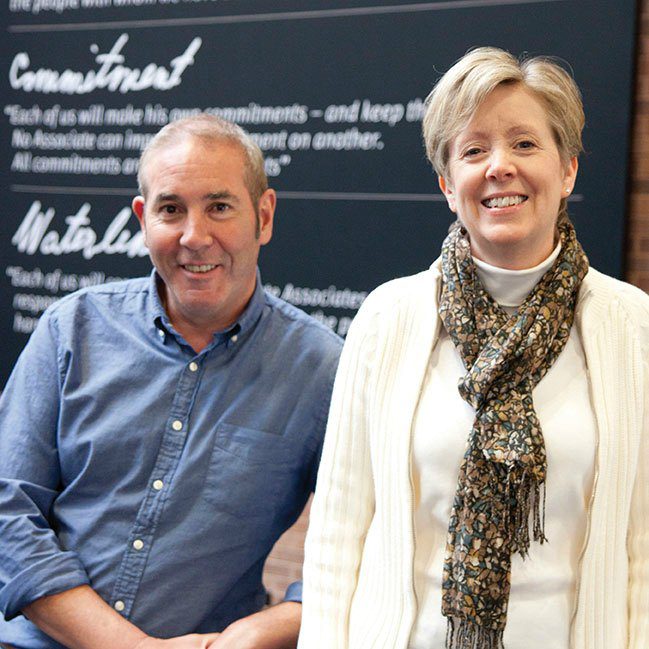W.L. Gore & Associates Inc. is one of those mythical companies that has managed to maintain a completely flat corporate hierarchy, even as it grew to more than 10,000 employees worldwide.
There are no managers or executives at the organization — which makes Gore-Tex, a waterproof fabric, and thousands of other products ranging such as synthetic vascular grafts and Glide dental floss — and no one holds a title that establishes his or her status above or beneath anyone else. “We are all associates,” said Mary Ellen McEnroe, who is part of the company’s People Center of Excellence, or PCoE.
Instead of management hierarchy, the company relies on the power of sponsors — Gore associates who serve as coaches, mentors, talent scouts, promoters and personal counselors for each other to keep the business functioning. “Everyone has a sponsor, even the CEO,” said Debra France, associate in the leadership development and learning for innovation group. “They make sure you figure out what you are passionate about and where your passions match the business needs.”
Sponsors are like a built-in development tool because senior people look out for the next generation, making sure they develop the skills and relationships they need to be productive, high performers. They also provide sponsees with access to their “lattice,” or network of people within the company. This sponsor model is key to leadership development at Gore, France said. “We grow leaders organically through experience and mentoring, and sponsors are embedded in that process.”
Because sponsorship is a core part of the Gore culture, it is also a significant part of the company’s learning and development strategy. “It is a different model for leadership, and it doesn’t come naturally to everyone,” France said. It also requires a fair amount of each associate’s time. Sponsors need to understand why it’s important to the business model so they will be committed to it.

To provide associates with foundational knowledge to become an effective sponsor, McEnroe developed a classroom course eight years ago, an introduction to sponsoring, which has been voluntarily taken by 3,500 associates so far. The course explores the business case for Gore’s sponsorship model, and the importance of sponsors to the company’s agility and innovation goals.
McEnroe’s team also offers specific courses on things like how to coach, how to give feedback, how to write an advocate letter and how to pick up on nonverbal cues. “A lot of these courses involve scenario-based learning where trainees look at real-life situations and what a sponsor might do to help their sponsee,” she said.
Associates also can participate in external, situational leadership training program from the Ken Blanchard Cos., which is an extension of the sponsoring core skills program. “It provides a lens to help determine what kind of support an associate will need depending their development,” said Patrick McCarroll, an associate in the PCoE.
The PCoE is also looking at a virtual adaptive learning course, offered through CorpU called “Leading an Adaptive Organization.” Gore associates from across the globe would be able to work together in a virtual environment to discuss specific company goals and challenges. France said the virtual environment was specifically chosen to help the company deal with some of its growing pains.
“Once we passed 7,000 employees, we needed a little more structural support around our leadership development,” France said. In a virtual classroom, associates will be able to work with their peers across the globe to further develop their lattice and learn lessons from small teams in other parts of the company.
The learning and development group also offers tools to help sponsors manage their day-to-day relationships, including an alignment form that sponsor and sponsee complete and share with each other to ensure they are aligned about how they work together. “It’s a useful way to check in with each other on the health of the relationship,” McEnroe said.
My First Sponsor
Employees are assigned a sponsor as soon as they’re hired to help them get acquainted with the company. But that’s just the beginning. Once they are settled in, associates are expected to seek out their own sponsors based on their development goals and career aspirations.
For example, if an individual wants to become a leader in operations, that person might choose a sponsor who’s been in that department for years to mentor them and put them up for stretch assignments to build experience. “It’s all about making sure people have rich opportunities and someone to talk to who knows what they are facing,” France said.
Associates also can change sponsors at any time. This is one of the ways the company assesses employee productivity and ensures development is always ongoing and appropriate to that person’s current business goals.
McEnroe chose her sponsor seven years ago. When she joined Gore, she had a lot of experience in learning and development, but was brand new to the lattice corporate culture and needed to figure out how to gain the global HR team’s respect. So she chose a person who had been with the company for 17 years and spent much of his time in HR. They talked about her goals and his ability to support her, and he agreed to take on the role. “He had a strong HR lattice and was able to connect me with people all over the company,” she said. “It would have taken me much longer to build those connections on my own.”
Sponsors are also supposed to act as advocates to ensure their sponsees get the development opportunities they need to become high-performing leaders, McCarroll said. One of his sponsees recently shared with him that she felt like she had gone as far as she could in her current commitment and asked him for help figuring out what to do next. McCarroll reached out to his lattice and found her a new, more challenging opportunity. “Now she’s working on a global project where she will have more opportunities to develop her skills and move within the company,” he said.
Advocacy doesn’t begin and end with sponsees, however. Associates are also expected to advocate for each other as part of the company’s “freedom principle,” which says associates should encourage everyone on their team to grow and learn new skills. That means helping associates find new opportunities even if it means putting added pressure on your own team, McEnroe said.
For example, her team has an associate who has always managed the learning management system and done an excellent job, but McEnroe and her colleagues thought he should have a chance to try something new. So they moved him to a totally different type of IT project within the HR group.
“It means he has less time to spend on the LMS, but it will broaden his skill set and he’s a great addition to that team,” she said. It adds extra work for her in the short term, but the company benefits in the long term, and she said she considers it a good decision.
Sponsorship 101
While training and tools provide big-picture guidance and support, sponsors and sponsees have to figure out the details of how they will work together on their own. McEnroe, for example, meets formally once a month with all of her sponsees, while McCarroll connects with his more casually only when they need something or he feels like they should catch up. “It’s a two-way relationship, and you have to figure out what works for both people,” he said.
That’s how a lot of things work at Gore. People adapt to the environment, and sponsors and sponsees organically figure out what they need to do to be effective. And if sponsees aren’t getting what they need, they “vote with their feet” by choosing a new sponsor. “People leave sponsors for a lot of reasons,” McCarroll said.
Sometime a sponsor can be over committed, especially if they are juggling several sponsees at once or the sponsee needs a lot of attention. A sponsee also may choose a new sponsor when they change roles and feel like they could benefit from someone with a different background or lattice to guide them. Other times, a sponsor may turn down a request because they just don’t have room in their schedule or don’t feel like they can give that person what they need.
While all of these relationships — and the learning to support them — are voluntary, it is made clear to every associate as soon as they are hired that sponsoring is a vital part of the company, and they are expected to play their part. Fortunately, associates don’t need much encouragement, McCarroll said. “Once they see the power of our culture, they have a vested interested in maintaining it.”
As a result, Gore is one of the most respected organizations in the world. Its unique corporate culture and approach to leadership development has helped land it on Fortune’s 100 Best Companies to Work For list every year since the list began in 1984, and on the World’s Best Multinational Workplaces list from the Great Place to Work Institute for the past three years. But lists don’t prove the value of this process, McCarroll said. “Our ability to continue to innovative and grow is how we know it works.”
It is effective, but it’s not a model that can be easily replicated, especially in a big company with a hierarchy in place. However, McEnroe and McCarroll said they both believe smaller companies that haven’t yet established a lot of management infrastructure could do it. “If you are a start-up and you want to maintain your flat corporate culture, focus on creating small teams and remove all of the policies, practices and bureaucracy that get in the way of associates being productive,” McEnroe said. “That’s the simplest way to make this model work.”















